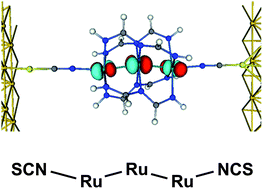Density functional theory is used to reconcile the structural, magnetic and electron transport properties of a triruthenium extended metal atom chain, Ru3(dpa)4(NCS)2. The distinct bending of the Ru–Ru–Ru core in this species is traced to strong second-order mixing between levels of σ and π symmetry that are near degenerate in the linear geometry. The dominant electron transport channel is formed by the LUMO, an orbital of π* symmetry that lies just above the Fermi level of the gold electrode. The bending has a substantial impact on electron transport in that it induces a spin crossover from a quintet to a singlet which in turn brings the LUMO much closer to the Fermi level. The presence of significant net π bonding in the metal chains also broadens the π/πnb/π* manifold, such that the channel is not strongly perturbed by the electric field, even at a bias of 1.0 V. The presence of a robust π symmetry conduction channel marks the triruthenium systems out as quite distinct from its first-row counterparts, Cr3(dpa)4(NCS)2 and Co3(dpa)4(NCS)2, where current flows primarily through the σ framework.

You have access to this article
 Please wait while we load your content...
Something went wrong. Try again?
Please wait while we load your content...
Something went wrong. Try again?


 Please wait while we load your content...
Please wait while we load your content...